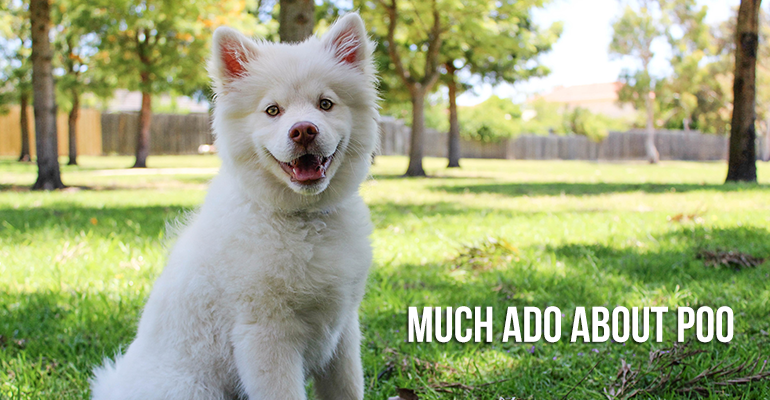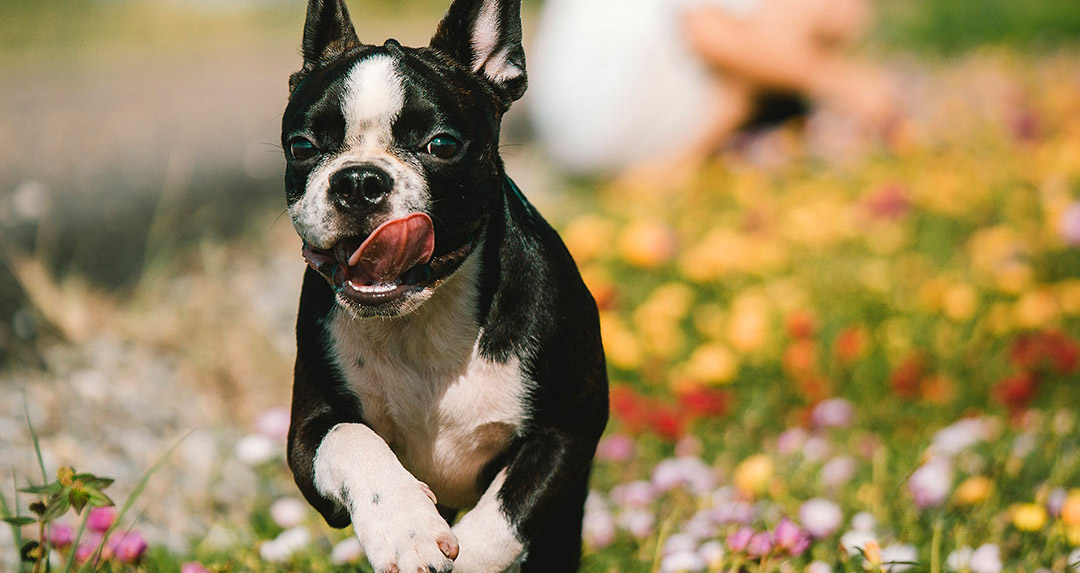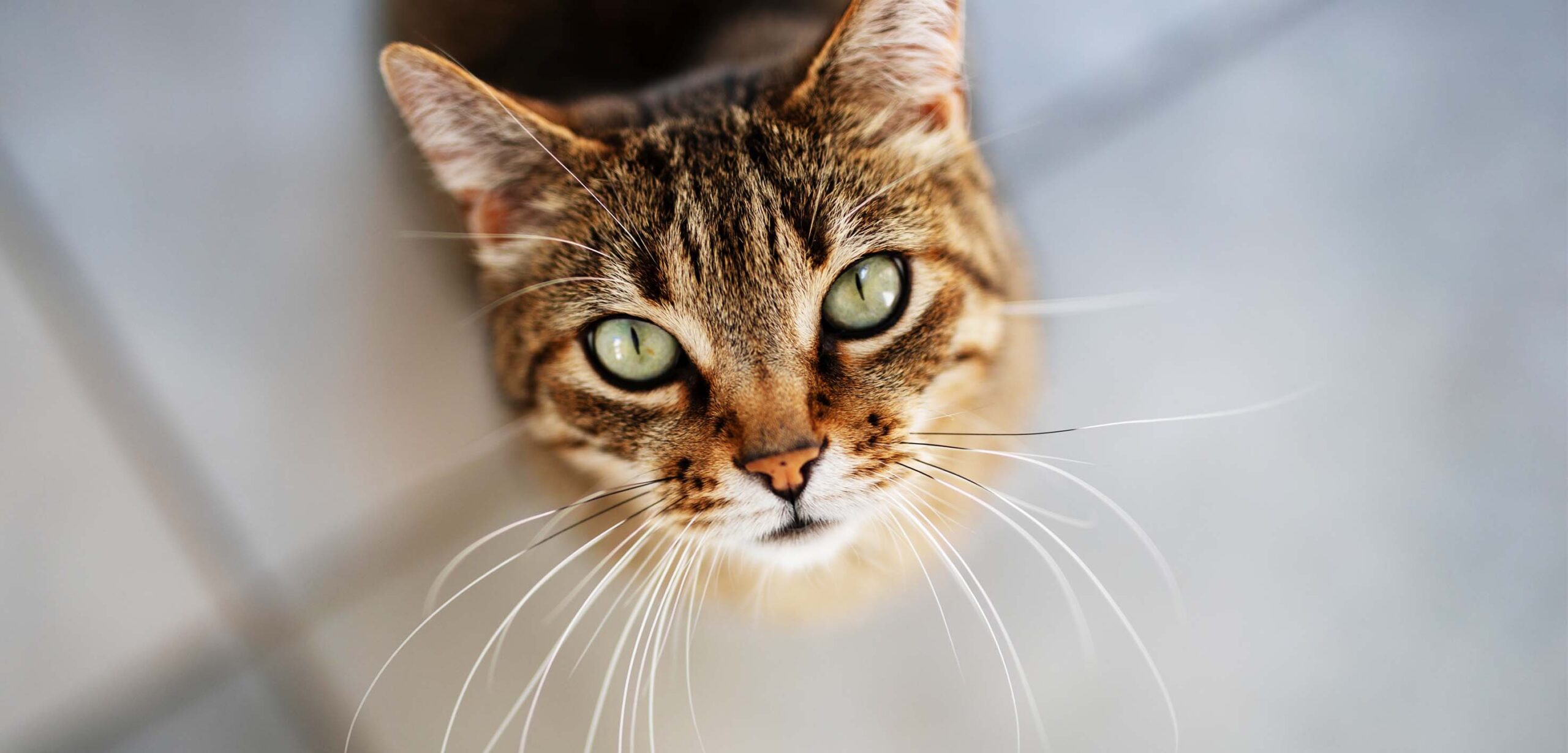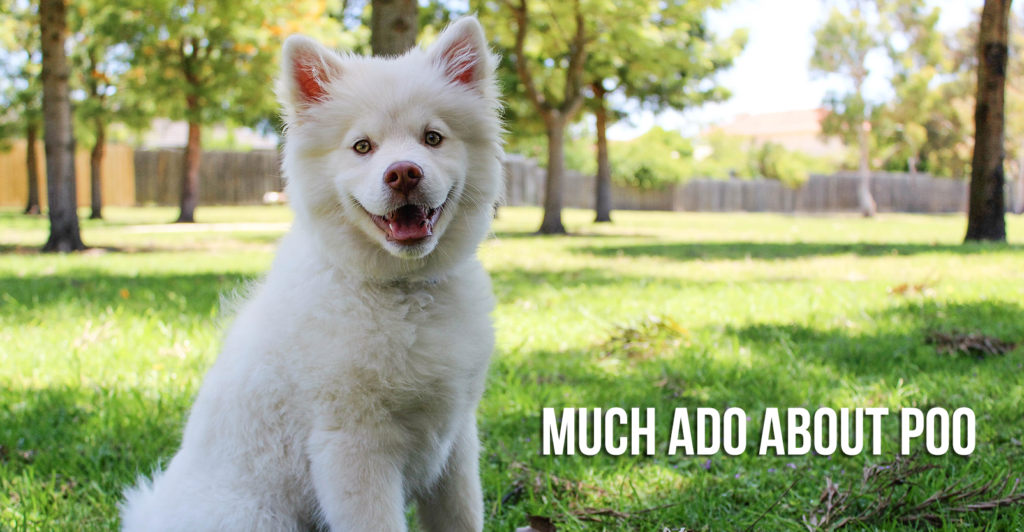
I had a mischievous chocolate lab named Iz who once ate several multi-colored water balloons. Don’t ask me what motivated her, because I still scratch my head at the things she deemed edible. She pooped balloons for a week. I know because I diligently stood watch every time she squatted down and because brightly colored balloons are not difficult to discern from brown. The point is, dogs eat things they have no business digesting and thankfully, hopefully, their digestive system cuts them some slack. Sometimes though, the digestive system has issues (and not just with balloons). When the digestive system isn’t working the way it should, it lets everyone know, which is a good thing! Symptoms are signs that your body is in distress and needs help. (Try to remember this the next time you’ve got a gassy cat or a constipated dog.)
Most poo issues work themselves out in a day or two but beyond that, a call or trip to the vet may be warranted. Your dog’s attitude is also a good indicator of whether the stool issues are serious. Izzy for example, kept eating devouring (she was a Lab) and drinking normally, so I assumed she was fine. If she had become lethargic or stopped eating and drinking it would have been more cause for concern.
The digestive system deals in waste so pet parents have to become proficient at what their pet’s poo is trying to say. Stool can be hard to sort out (literally): there’s color, consistency, content, and coating. When your dog is healthy, his poop should show it, which is why it’s important to know what’s “normal” for stool. The ideal poo (passed daily) is chocolate brown in color, shaped like a log with a firm consistency and a bit moist. The volume of waste should reflect the amount of food they consume which is of course dependent on their diet. Now that we have a “normal” poo standard we can more easily identify when irregularities come about.
Colors of the (Poop) Rainbow
A few things to make note of when it comes to the color of poo. Some variation in color is actually normal but there are certain colors that are always worth looking at more closely. If you shake up your pet’s diet, color changes are also possible if your pet food uses any dyes (personally, not a fan). Any deviation from brown that lasts longer than one or two stools should raise flags.
Now down to the nitty gritty with this poop color chart.
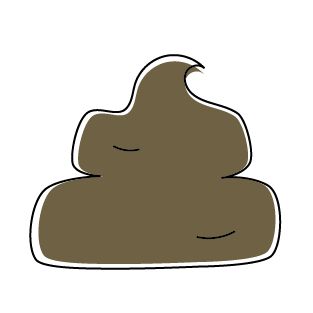
Brown
Normal & Healthy
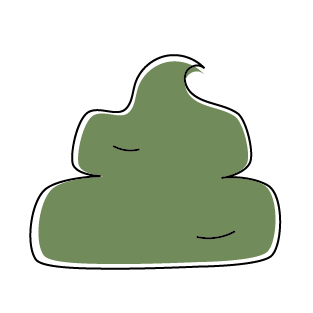
Green
May be bile indicating an issue with the liver or the flow of bile
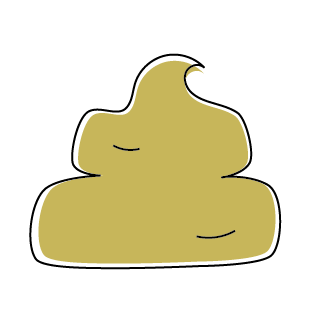
Yellow
Can be a simple reaction to something they ate or a sign that they passed stool too quickly (the bile didn't have time to reabsorb); when accompanied by an acidic smell it can mean liver distress and should be addressed with your vet immediately (this is not a drill)
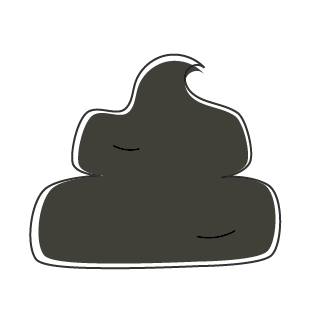
Black & Tarry
Blood was digested which can mean bleeding in the upper digestive tract (stomach or small intestine); cause of bleeding could vary from swallowing blood from a bloody nose to an ulcer or tumor
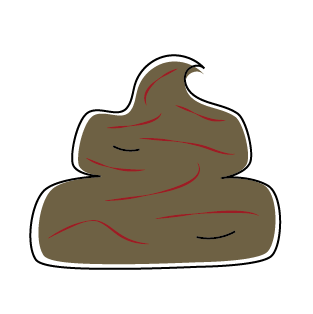
Red Streaks
Bleeding in the lower part of the digestive tract (large intestine or rectum); cause of bleeding could vary from your dog straining to pass dry, constipated stool to more serious issues like colitis, cancer, colon ulcers or hemorrhoids
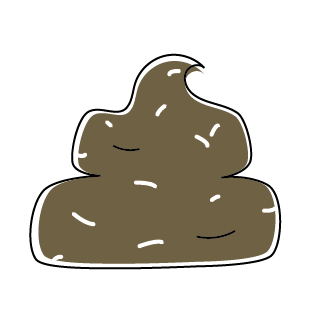
White Specks
Can be signs of parasites; tapeworms look like little white grains of rice and roundworms look like linguini
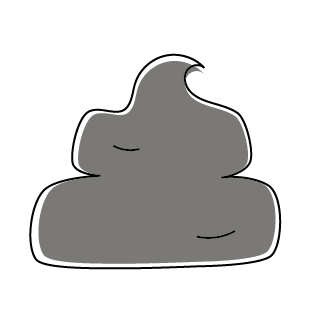
Grey & Greasy
Issues with pancreas, liver or gallbladder
Basically, any color other than brown on the color chart is cause for concern if it persists for more than one or two stools. It’s best to contact your veterinarian who can evaluate a sample (you’ll want to grab a scooper).
Consistently, Consistent Consistency is Key
There’s a sliding scale for stool, ranging from entirely liquid to very hard/dry. You want your pet to stay away from either end. The stool of a healthy animal is firm and holds its form when picked up.
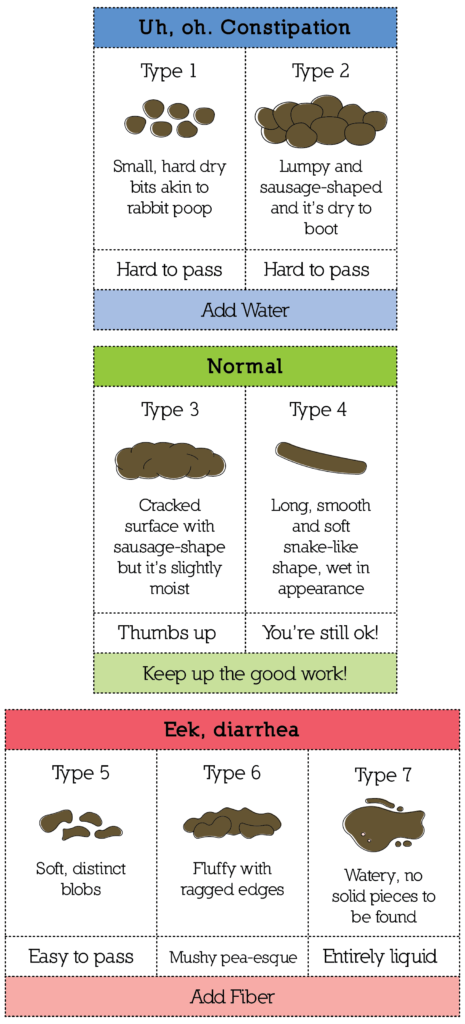

Loose stools in cats and dogs (5-6 on the scale) can be blamed on the colon (sorry, colon). One of the colon’s main jobs is to absorb water, from the foods being digested, to firm up the stool. An inflamed colon can’t absorb water as well so stool sneaks past while it’s still watery and loose (several times a day, in fact). Causes of loose stool in cats and dogs could be a result of parasites, food intolerance or lack of fiber. (If your dog or cat has loose stool it can cause issues with the anal glands.) Adding fiber to your pet’s diet can help stimulate the colon so it’s able to absorb more water and firm up stool. If fiber is added and loose stool persists or comes back, it’s because the colon is still inflamed. The next steps would be to investigate whether parasites or a food intolerance is to blame. Also, keep in mind that just like people, stress and anxiety can have quite an impact on the digestion and elimination systems. Make note of whether the problem clears up on its own, because generally if it does in a day or so, your pet may have had stress poos. Being a mild symptom, soft stool is less of a concern than a cat or dog with diarrhea. Dog or cat diarrhea (7 on the scale) should be watched a bit closer because it puts your pet at risk of dehydration. Be sure to give them plenty of water to combat this. Like soft stool, diarrhea can be caused by a number of factors. It can be attributed to change in food, especially for a dog with a sensitive stomach, gastric distress, stress, or eating things they shouldn’t. An urgency to poop is often times an irritation of the anus or rectum or pending diarrhea (so hustle to grass).
Constipation is on the other end of the poo scale (1) but is still equally uncomfortable for your pet. Consistency and frequency will help identify constipation. Small, hard, dry poop passed less than once a day indicates a constipated cat or dog. If your pet is straining to go it’s also a red flag. If you don’t know how to tell if a cat is constipated, check whether their food intake has slowed. Or if you don’t scoop daily, you may want to start if you’re concerned they may not be going every day. Constipation can be caused by dietary issues, either their food is too difficult for them to digest, or they’re lacking fiber. It’s also caused by that pesky colon and water imbalance. When stool is extremely hard, the body took all the water out in an attempt to hydrate itself. Add more water to your pet’s diet because they’re likely dehydrated.
Contents and Coating
Coating is easy enough for a pet parent to spot because it will leave residue on the ground when you pick up your pets’ poo. It should never be on stool though so if it is, it’s likely mucus that lines the gastrointestinal tract. This is a sign of gastric upset and inflammation and because the cause of this upset can vary it’s best to see a vet if it persists beyond 24 hours and is paired with vomiting and diarrhea.
Contents of poo is a bit more involved. No pet parent really wants to get their hands dirty rummaging through the contents of poop, but you do what you gotta’ do for your four-legged family. (You can also send it to your vet for them to rummage through.) If any of these things find their way into your pet’s stool, you’ll want to follow up.
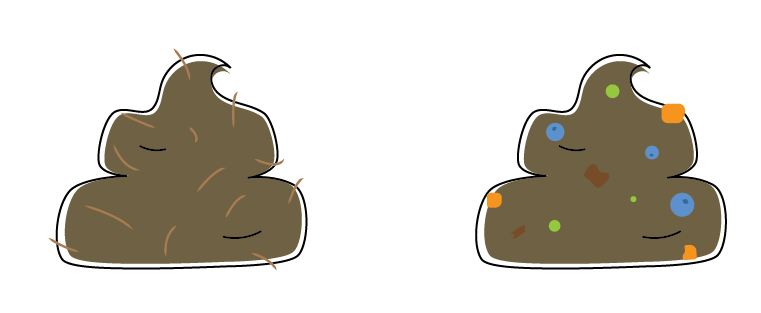

Flecks of white, as previously mentioned, can mean worms if it’s found in a fresh pile of poo. Excessive amounts of grass may have been your pet’s attempt at helping his GI upset. To narrow down the upset, you may want to start troubleshooting with the following: the possibility of a food intolerance, over-eating or they’re eating things they shouldn’t. Clumps of hair found in poo may mean overgrooming due to stress or allergies. Undigested food means your dog isn’t getting all the nutrients he needs out of the food. Vegetables and fruits are most often found. As carnivores, they rip, tear and gulp their food, so high cellulose items like fruits and vegetables don’t get broken down prior to swallowing (humans are able to grind their food, which breaks it down before it even gets to the stomach). Dogs also don’t have a lot of salivary amylase to break down fruits and vegetables the way humans would (we can immediately begin digestion of starch and sugars while chewing). Because they have so little salivary amylase in their mouth, dogs rely on their pancreas to break down these complex starches and sugars and as you can see (literally), they don’t have a 100% success rate.
Dogs and cats are wily with food and at times, things, so it’s best to consider sneaking a peek at the contents of poo once in a while to gain insight into their digestive health.
How to Help a Bowel Naturally
The color, consistency, coating, and content of poo all help to identify digestive distress. Symptoms manifest in poo to tell pet parents that their pets are having a tough time with their digestive system. Really, poo deserves a round of applause because we aren’t able to see inflammation or ask our pet where it hurts. All pets could use a digestive aid from time to time (or every day if you wanted!) especially during diet change or during times of environmental stress. There are plenty of herbal supplements that can help GI tract inflammation which is a key contributing factor to a sensitive stomach in pets. Slippery elm is one herb (literally) that can be used as a digestive aid but also to ease occasional diarrhea and loose stool. The herb lubricates the protective layers of the bowel which guards the inflamed mucous membranes from further damage, allowing them to heal. For pets with sensitive stomachs, pair slippery elm for cats and dogs with GastroCare. GastroCare is also a completely natural herbal formula that keeps the digestive process regular so your pet is too.
